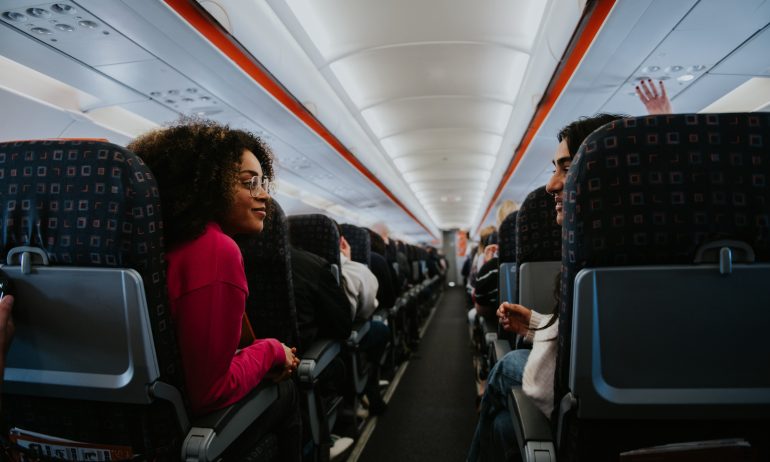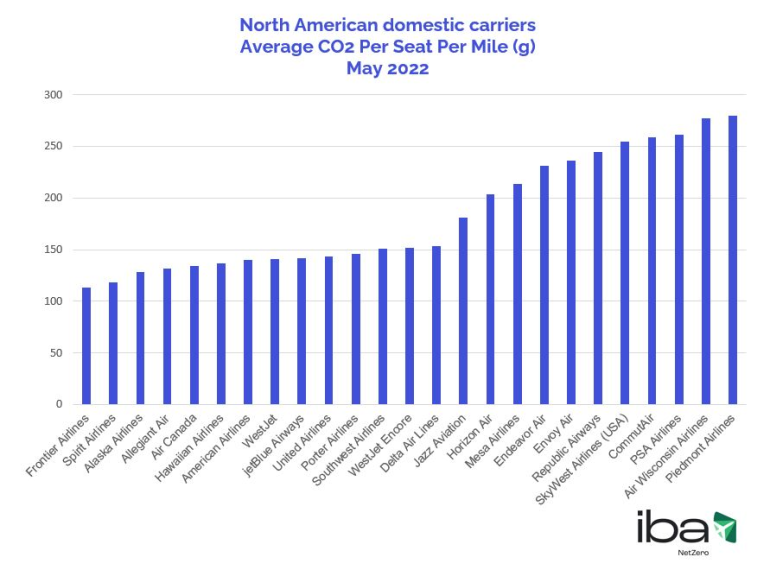Ask a Travel Nerd: Environmentally Friendly Air Travel for Cheap Stoics

Many or all of the products featured here are from our partners who compensate us. This influences which products we write about and where and how the product appears on a page. However, this does not influence our evaluations. Our opinions are our own. Here is a list of our partners and here's how we make money.
As someone who cares about my environmental impact and spending as little money as possible, life is full of fraught decisions.
Should I buy organic milk even though it’s twice as expensive? Or choose an electric car for $40,000 rather than a friend’s run-down Corolla for $3,000?
Should I make eye contact with the person on the street raising money to fight climate change or awkwardly pretend to be on a phone call?
The point is that my aversion to spending money often means I’m cutting corners environmentally. Yet when it comes to air travel, these preferences aren’t in conflict. In fact, reducing one’s travel carbon footprint can actually mean spending less on airfare.
The only downside: It means flying with airlines that pack you in (and treat you) like sardines.
The high cost of legroom
Flying burns a lot of fossil fuels — there’s no way around that fact. If the entire commercial aviation industry were a country, it would rank sixth (between Japan and Germany) in total emissions, according to an October 2019 report from the Environmental and Energy Study Institute.
But not all means of traveling by air have the same impact. More expensive seats, such as premium economy, business class and first class, burn more fuel per passenger than the sardine-like conditions at the back of the plane.
How much more? A lot.
Flying in first class on a widebody jet creates a carbon footprint nine times larger than flying in economy, according to a report from the World Bank's Environment and Energy Team, Development Research Group.
That’s the first bit of good news for cheap, environmentally conscious travelers like me. You can save money and shrink your carbon footprint at the same time by choosing economy fares.
And that’s not all. Because not only does what cabin you fly in matter, but so does the plane’s layout.
Enter budget airlines
Imagine two types of bus: One that carries 50 passengers and one that carries 25. Assuming the fuel consumption is roughly similar for both, which bus would be more efficient in terms of gas burned per passenger mile?
Obviously, the more packed bus is more efficient.
Yet we often overlook the parallel with air travel. Some Boeing 737s, operated by low-cost airlines, carry far more passengers than the same 737s operated by airlines with first- and business–class seats, simply because they lack a first-class cabin.
That’s why budget airlines Frontier and Spirit ranked best regarding carbon dioxide emissions per seat mile (in grams) in a 2022 analysis by IBA, an aviation consulting firm.

In fact, the report specifically cites the high density (i.e., sardine-like) seating of Frontier’s aircraft as a major reason why the airline ranked so well.
Another reason budget airlines are dark-horse climate winners: They offer several nonstop flights.
For example, the new low-cost airline Zipair offers four routes from the U.S. directly to Tokyo. Flying direct in this way reduces emissions simply because it covers less distance and burns less fuel.
Flying direct often means paying more, but these low-cost airlines have turned that logic upside down. That means you can spend less, emit less and spend less time in the air.
So what’s the catch?
No such thing as a free soda
Low-cost airlines might be more environmentally friendly on the whole, and their fares can be cheaper on the surface, but actually saving money with them can be challenging. That’s because they generate much of their revenue through add-on fees on top of the base fare.
Expect to pay for everything from a can of soda to the opportunity to select your own seat. In fact, the cost of a flight with an airline like Spirit can quickly balloon past the cost of the same flight with a traditional carrier if you’re not careful.
That’s where stoicism comes in. Yeah, you’re paying and emitting less, but only because you’re giving up on "frills" like legroom and free drinks. That might be fine for a two-hour flight, but it will test even the steeliest nerves for a trans-Pacific one.
The trick is to pay for only the frills you actually care about. Budget airlines will try to push countless add-ons during checkout, from bundles to trip cancellation protection.
Some of these might be important to you, others less so. Being ruthless in turning down the latter is the only way to keep these costs low, and keep budget airline travel something you will want to continue doing in the future.
I like to treat this add-on fee system like a game that I’m winning by refusing to bite on needless add-ons. The fact that I’m reducing my carbon footprint while saving money is just the cherry on top.
How to maximize your rewards
You want a travel credit card that prioritizes what’s important to you. Here are our picks for the best travel credit cards of 2024, including those best for:
Flexibility, point transfers and a large bonus: Chase Sapphire Preferred® Card
No annual fee: Bank of America® Travel Rewards credit card
Flat-rate travel rewards: Capital One Venture Rewards Credit Card
Bonus travel rewards and high-end perks: Chase Sapphire Reserve®
Luxury perks: The Platinum Card® from American Express
Business travelers: Ink Business Preferred® Credit Card
on Chase's website
1x-5x
Points60,000
Pointson Chase's website
1.5%-6.5%
Cashback$300
2x-5x
Miles75,000
Miles




